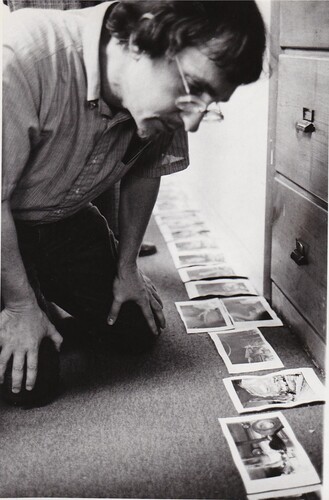DEBORAH BRANDT
When I returned to do a PhD at Michigan State University in 1971, I brought my passion for radical education and for photographic methods. With the support of my supervisor Fred Waisanen, also a photo afficionado, I was able to establish a darkroom, create an interdisciplinary visual methods course, write a major paper (Towards a Visual Study of Society) and organize the first conference in Visual Sociology in 1974.
Howard Becker brought to that gathering his own unique way of thinking about photography and society, often outside of the box, in both research subject and process. Who else focused on jazz clubs and marijuana users as legitimate social phenomena?
I was attracted to Howie’s irreverence and playfulness in his research methods. I recall him using photographs to illustrate the statistical tool of the four-fold table. He invited two friends to pose for photos in various states of dress and undress on the top and bottom half of their bodies, visually representing a quantitative tool through art and humour.
I sought him out for advice before I set off for field work in Peru on Brazilian Paulo Freire’s Pedagogy of the Oppressed in 1975. I had been frustrated by positivist sociologists’ attempt to reproduce the methods of the natural sciences. I was anxious about the unknowns of my field work, a young gringa about to plunge into the Peruvian cultural context.
Howie advice: ‘Look at it this way: Every morning you get up and you make a new hypothesis. And every day, it is shattered. You’re wrong! And that’s great! It means that you are getting closer to understanding the reality you are observing and experiencing.’
I have since repeated Howie’s wisdom many times to my own graduate students, encouraging humility and embracing mistakes as learning moments.
MIMA CATALDO
I met Howard Becker as a young graduate student during the mid 1970s in upstate New York. He led the way for those of us who were both sociologists and photographers to pursue research studies that could shine a unique light on our observations. He encouraged us to use the camera as a research tool (as we would with paper and pen) and use photographs to inform our discovery process. I was easily drawn to this methodology and discovered that while I was developing my observation skills, I could, at the same time, forge an artistic niche for self-expression. The techniques I learned then have stayed with me during my various academic and artistic careers, and I am forever grateful for Howie’s friendship and guidance over the years.
TIMOTHY CURRY
I was fortunate to be able to attend a summer workshop taught by Howard Becker at the Visual Studies Workshop in Rochester, New York in 1974. Photographers and sociologists who participated in this workshop shared their experiences and learned from each other. As a sociologist I was intrigued by the challenge of learning how to take better pictures and make more accurate sociological statements with photographs. I teamed up with a photojournalist who attended the workshop, and together we studied at the same organisation, a private nursing home. One of the photographs I took of Howard Becker at the workshop is reproduced here (). I think it captures his intense involvement in the process of interpreting photographs and creating photo-essays that describe life and raise awareness of sociological processes.
FIGURE 1. Tim Curry. ‘Howie Becker at Visual Studies Workshop in Rochester, New York, 1974.’ Courtesy Tim Curry.

Becker’s work stimulated my interest in making visible all types of social processes, and I considered visual sociology a boon to my teaching as well as research. Three years after the workshop I coauthored with Alfred C. Clarke a workbook of projects aimed at making visual sociology available for college classroom instruction. The workbook was entitled Introducing Visual Sociology (Curry and Clarke Citation1977). I used some of the photographs created at Howard Becker’s workshop in the workbook. Following that project, I began to use photographs to study college sports. I discovered that to photograph a sport, I needed to understand the complexities of the sport, and so I began to research more deeply into the culture of college sports, particularly wrestling. I used the photographs I took at wrestling matches to study the normalisation of pain and injury experienced by wrestlers, and I wrote about a visual method of studying sports, the photo-elicitation interview. I am forever indebted to Howard Becker for his encouragement in these undertakings.
Additional information
Notes on contributors
Deborah Brandt
Deborah Brandt is a Professor Emerita at York University in Toronto.
Mima Cataldo
Encouraged by Howie Becker to combine her interest in Photography with Social Science research, Mima Cataldo taught courses in area colleges of New York state for several decades, including Visual Sociology within the Honors Program of Syracuse University. Her social documentary projects and subsequent publications have been exhibited nationally, are included in several institutional and private collections, and recognized today for providing historical perspective on the lives of women, peace and gender studies. (www.MimaCataldo.com)
Timothy Curry
Timothy Jon Curry is a past president of the International Visual Sociology Association and the North American Society for the Sociology of Sport.
Reference
- Curry, Timothy, and Alfred Clark. 1977. Introducing Visual Sociology. Dubuque, IA: Kendall/Hunt publishing Company.
